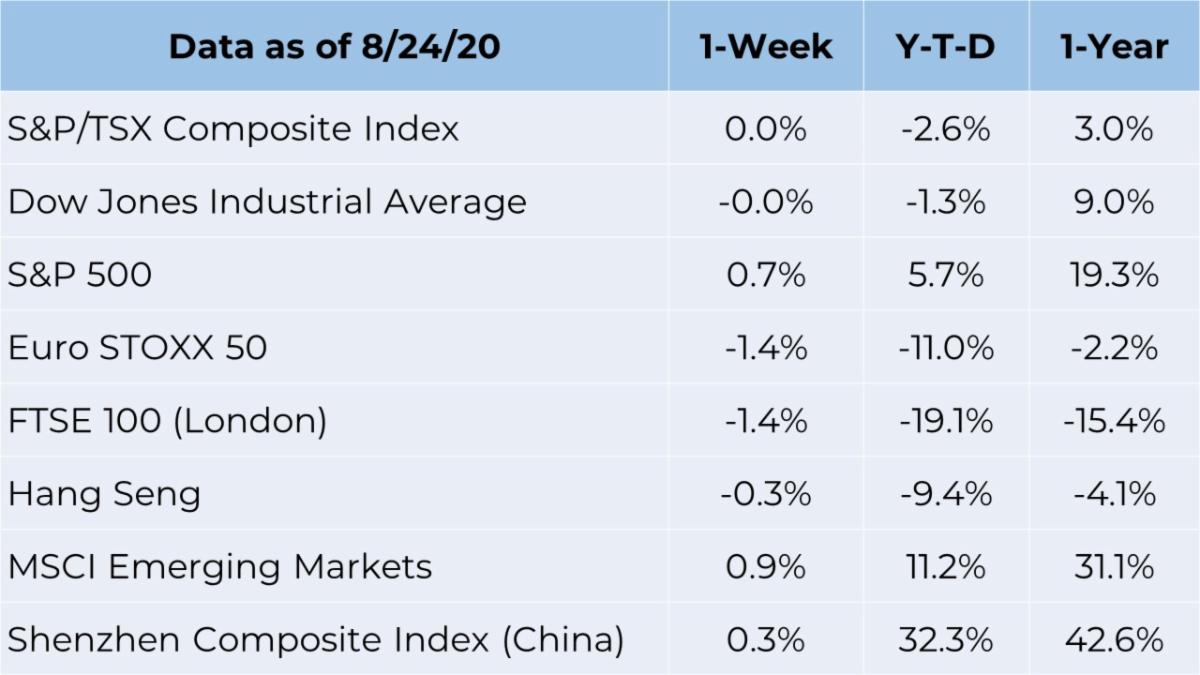Weekly Market Commentary August 25 2020
The Markets
The Nasdaq Composite and S&P 500 indices finished at new highs last week, while the S&P/TSX Composite index, which has also rebounded impressively from its low point, finished the week approximately 8 percent below the high point in February. The stock market is considered to be a leading economic indicator, so strong stock market performance suggests economic improvement ahead.
There was a caveat to last week’s gains, though. One large technology company was responsible for 60 percent of the S&P 500’s weekly gains (0.7 percent), reported Ben Levisohn of Barron’s. The same large company is also a component of the Dow Jones Industrial Average, which finished the week flat. Without that stock, the Dow would have finished the week lower. Levisohn wrote:
“The S&P 500 might have hit a record last week, but most stocks have been having bad days. On Friday, for instance, just 220 stocks in the S&P 500 closed higher for the day, and that was far from an anomaly. The S&P 500’s cumulative advance/decline line – a measure of the number of stocks finishing higher versus those finishing lower that technicians use to gauge the market’s underlying strength – has been falling even as the S&P 500 progressed to a record.”
One reason for the stock markets’ rise to date may be dividends, reported Lawrence Strauss of Barron’s. “…equities remain attractive relative to 10-year U.S. Treasuries. The yield on that bond was recently at 0.67 percent, about one percentage point below the S&P 500’s yield.” Though Strauss was describing the situation in U.S. financial markets, the same can be said for 10-year Government of Canada bonds.
The story told by last week’s jobs data was as uncertain as the one told by the stock market. The U.S Department of Labor reported jobless claims moved higher with 1.1 million people filing new claims for the week of August 15. During the previous week, new claims had fallen below one million. The four-week moving average for new claims continued to trend lower.
The unemployment rate dropped from 10.6 percent to 10.2 percent in the U.S., and from 12.3 to 10.9 in Canada. That’s an improvement when compared to the high point, but the rate remains historically high. As a point for comparison, during the Great Recession, the unemployment rate in the United States peaked at 10.6 percent in January 2010, according to Rakesh Kochhar of Pew Research Center.
There was also a decline in the number of jobs posted. (Job postings provide insight to labor market activity in real time.) The Indeed Hiring Lab reported postings were down more than 20 percent year-over-year as of August 14, 2020. It was the first decline in the number of job listings since April 2020. Fewer jobs were available in hospitality, tourism, childcare, banking, finance, and software development.

Source: Refinitiv
Improbable Research
The Annals of Improbable Research publishes “…research that makes people LAUGH, then THINK. Real research, about anything and everything, from everywhere – research that’s maybe good or bad, important or trivial, valuable or worthless.” In that spirit, here are a few notable scientific studies that may inspire awe and/or skepticism:
Coffee improves longevity. There has been a lot of research exploring whether coffee helps people live longer or shortens their life spans. A metastudy published in the European Journal of Epidemiology found people who drank two to four cups of coffee a day were likely to live longer than those who drank no coffee.
People don’t know what they don’t know – and they don't know it. The Dunning-Kruger Effect is a cognitive bias in which people wrongly overestimate their knowledge or ability in a specific area. “Not only do these people reach erroneous conclusions and make unfortunate choices, but their incompetence robs them of the metacognitive ability to realize it.” Notably, when the unskilled are trained and develop skills, they recognize the limits of their abilities.
Insights about alligators on treadmills. Researchers at the University of Utah found, “…alligators, unlike lizards, are able to walk and breathe at the same time by using a rocking pubic bone – part of the pelvis – to help them inhale and exhale,” reported Science Daily. A study published in the Journal of Comparative Physiology reported alligators that trained on treadmills for 15 months improved their peak oxygen rate by 27 percent.
Arachnids fly the friendly skies. Venomous pseudoscorpions, which are tiny predatory arachnids, have perfected the art of hitchhiking. They attach to flying insects, such as beetles, when they want to travel to new hunting grounds, reported National Museum Publications.
Weekly Focus – Think About It
“All sorts of things can happen when you’re open to new ideas and playing around with things.”
--Stephanie Kwolek, Chemist and inventor of Kevlar
Best regards,
Eric Muir
B.Comm. (Hons.), CIM®, FCSI
Portfolio Manager
Tracey McDonald
FCSI, DMS, CIM®
Portfolio Manager

